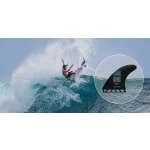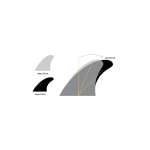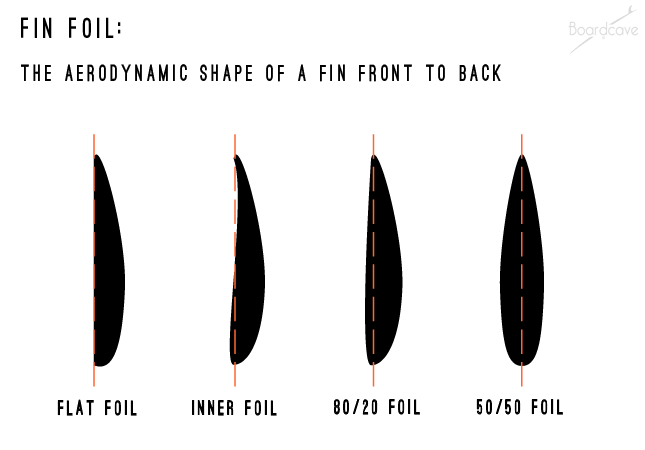The Definitive Surfboard Fin Guide
Fin Basics
Click the below link to jump to the section:
Fin Size |
Fin Base |
Fin Depth |
Fin Rake |
Fin Foil |
Fin Cant |
Fin Toe
Some more advanced stuff...
For more info on the advanced fin characteristics, click the link below to jump straight to it:
Fin Shape |
Construction and Materials in Surfboard Design
Fibreglass Fins |
Composite Fins |
G10 Materials |
Performance Core Fins |
PC Materials and fin flex
Choosing the right fins for your surfboard
The fins you use in your surfboard play a big role on how the board will perform for you. Some claim that your choice in
Surfboard Fins makes up almost 40% of the board's performance.
Different boards or different conditions require different fins and fin set ups to work in the way that the shaper or
the rider intends them to.
The beautiful thing is, just like surfboards, fin design and experimentation is almost endless.
But before you start testing out these options, it's good to have an understanding of how each characteristic can impact
on your performance. So lets start with the basics.
 Craig Anderson showing some extreme release on his signature Futures template in Blackstix construction.
That is perfectly tailored to the way he surfs.
Craig Anderson showing some extreme release on his signature Futures template in Blackstix construction.
That is perfectly tailored to the way he surfs.
Fin Size
The overall size of the fin will make a big difference in the performance. A larger fin will have more hold and provide
more control in bigger surf, where a smaller fin will be loose and somewhat more forgiving, but lack the drive and
control needed in bigger surf.
 Difference between the FCS II Filipe Toledo
Large template and the Filipe Toledo
Medium. Same size base different fin area (mm²).
Difference between the FCS II Filipe Toledo
Large template and the Filipe Toledo
Medium. Same size base different fin area (mm²).
Fin Base
The base is the part of the fin that is attached to the board. A wide, or long fin base will help to produce more drive
and will allow you to draw out your turns. A narrow, or short fin base will be a little easier to turn, but will produce
less drive.
Fin Depth
The depth of a fin is how tall, or how deep into the water the fin goes from the bottom of the board. A deep fin will
have more hold and stability, whereas a shallow fin will provide more release when throwing your tail around in
turns.
 Fin Base and Fin Depth highlighted on the Futures - John John Florence Fin and the FCS II Mick Fanning Fin.
Fin Base and Fin Depth highlighted on the Futures - John John Florence Fin and the FCS II Mick Fanning Fin.
Fin Rake
The rake of the fin is how far back the fin tilts or sweeps. The more rake you have in your fin, the more drawn out your
turns will be, and are preferable on bigger days or when there is a long wall to work with. An upright fin will pivot a
little more and will be more useful on weaker or junky days.
The more 'Rake' the less 'Pivot' a fin will have.
 The degree of surfboard rake or surfboard sweep determines whether
you have a looser feeling in your fins or you get more pivot out of them.
The degree of surfboard rake or surfboard sweep determines whether
you have a looser feeling in your fins or you get more pivot out of them.
Fin Foil
The foil of a fin is the aerodynamic shape of the fin from front to back (much like an airplane wing), and help to
create some lift under the board. Fins are usually thicker around the centre and taper out towards the edges. There are
a few basic foils and many variations of these. Side fins (found on twins, thrusters and quads) are usually flat, or
sometimes curved inward on the inside, with it’s foil on the outside. Centre fins usually have equal foil or double
foil, on both sides. Commonly referred to as 50/50 or Symmetrical, these equal foils are usually found on single fins,
the centre fin on a thruster, or sometimes the
rear fins on quads and some keel fins on traditional fishes.
 Fin foil determines the volume of a fin as well as how the water
moves past your fins' sides.
Fin foil determines the volume of a fin as well as how the water
moves past your fins' sides.
Fin Cant
The cant of a fin is the outward angle of the fin in relation to the bottom of the board. A fin set up with zero cant
(straight up and down) is faster in a straight line, but not very responsive through turns. The more cant the fin has
(to a degree) the more responsive through turns. This helps keep drive up when the board is tilted and on rail.
 More Fin Cant means your fins are angled outward in relation to the
bottom of your surfboard.
More Fin Cant means your fins are angled outward in relation to the
bottom of your surfboard.
Fin Toe
The toe of your fin set up is the angle of the fin pointing towards the centre of the board. Common on the majority of
side fins, the toe of the fin helps to create pressure on the outside foil of the fin, allowing the surfer to have a
more responsive “feel” with the fin or the board.
 The Toe of a surfboard fin above shows the side fins angled towards
the stringer.
The Toe of a surfboard fin above shows the side fins angled towards
the stringer.
Check out some of Mick Fanning’s thoughts on
thruster vs
quad setups as well as why he chooses to change up his FCS II
fin sizes.
Mick Fanning explains how he uses his FCS II fins in different conditions.
Fin Shape
Now that you have the basic’s and the lingo down for what you are looking at when choosing
Surfboard Fins, let’s cover how the fin shape contributes to the
overall performance of your board.
Fin shape has a lot to do with how a board is going to perform. The best way to break down the basics is to use a Single
Fin for our descriptions.
When it comes down to it, quads and thrusters are more or less variations of these characteristics but broken down into
smaller versions usually with very similar total area when grouped together.
Much of a fin's performance is going to be directly related to flex.
Flex contributes to projection, which in turn produces speed and control. We will go more into detail about flex soon,
but for the purpose of this section and in particular reference to single fins, flex and the shape of a fin go hand in
hand.
Lets take a longboard as an example and have a look at how it will perform with 4 different fin shapes:
The Flex Fin, the Rake Fin, the Pivot Fin and the D Fin.
 Different shapes of Shapers Single Fins from left
to right Flex Fin, Rake fin, Pivot Fin, D Fin.
Different shapes of Shapers Single Fins from left
to right Flex Fin, Rake fin, Pivot Fin, D Fin.
The
Flex Fin (maximum flex) is a very versatile fin that can be used in everything from short stubbies and mid
length hulls, to 10 foot nose riders. They usually feature a wider base, tapering down to a narrow tip and offer very
little drag and a lot of projection when coming off a bottom turn.
The more raked back the fin, the more drawn out your turns will be; whereas the more upright, the tighter you
can turn.
The
Rake Fin (medium flex) kind of splits the difference between the Pivot and the Flex fins. A wide base but
with more tip than the flex fin, and usually starting out fairly vertical then sweeping back a lot towards the end.
These provide more projection and maneuverability than a Pivot fin, but still allow you to get the tail to hold when you
are up on the nose.
The
Pivot Fin (very little flex) is the standard go to template for nose riding. The feature a full vertical
outline, wide base and are designed to slow you down and help keep the tail in the water while you are up on the nose,
yet still allow you to step on the tail and swing (pivot) the board around in a relatively tight radius.
For tips on noseriding, check out our guide on
How to Noseride.
The
D Fin (no flex) is not the most versatile or forgiving fin to surf. Usually found on more classic, heavy
logs, they are harder to turn, and a little less stable while up on the nose. If you are looking for maximum trim
straight down the line, however, the D Fin is for you.
They feature a super wide base, a super wide tip and are generally the shape of a D. Sometimes they are found with the
straight vertical edge forward and curved side aft, and sometimes they're found with curved edge forward and vertical
edge aft.
These fins are generally placed as far back on the board as possible for maximum down the line trim.
To learn more, check out our dedicated
Longboard Fin Guide.
 Believe it or not, this original photo of Robert August and friends
in the 60’s depicts them holding the most modern surf craft of the time.
Believe it or not, this original photo of Robert August and friends
in the 60’s depicts them holding the most modern surf craft of the time.
Surfboard Fins 101
So there you have it. A starting point for understanding fins. Like I mentioned earlier, there are literally an
unlimited number of
Surfboard Fins and Surfboard combinations for
you to test out in different conditions. To make your search for the perfect fin setup easier, we offer a wide selection from some of the
best fin brands in the industry.
Check out Part Two of our Fins Guide below for a better understanding of materials and construction in surfboard fin
design.
Part 2 - Construction and Materials in Surfboard Fin Design
 Futures Fins giving us a look at the mould for their Alpha Fins. These are made up of
a carbon fibre compound that is strong and light.
Futures Fins giving us a look at the mould for their Alpha Fins. These are made up of
a carbon fibre compound that is strong and light.
Just like surfboards, there is an unlimited amount of innovation possible when playing around with fin combinations.
Materials, construction, cores, designs... there is no wrong way to build a fin and experimentation is what leads us to
great discoveries.
There are, however, proven designs that work and have worked for years. There are also, proven elements that we like to
look for when it comes to fins and surfboards...
 Kolohe Andino demonstrating why high performance surfing needs high
performance fins. Throwing his signature FCS
II template to the beach.
Kolohe Andino demonstrating why high performance surfing needs high
performance fins. Throwing his signature FCS
II template to the beach.
Recap of Part 1...
Like we discussed in part one, flex and fin shape are some of those key elements that make a fin act the way it
does.
Some people and some set ups prefer or require a more flexible, swept back fin for sweeping turns and projection -
others prefer a stiff upright fin for sharp turns and quick release. Not to mention the various degrees between the two
that can be used.
Fibreglass Fins
One of the traditional constructions found is the fibreglass fin. The construction of these fins involve laying up
multiple layers of fibreglass cloth and resin and then cutting and foiling the fibreglass fin shape by hand. These fins
are strong. Although the thinner you sand them back the more they will flex. For shortboards the size of the fins means
they are usually quite stiff. A stiff fin is the go-to for powerful waves when you want control and stability.
This type of construction is also great for traditional surfboard styles in single fin, and
twin fin templates where a
more sturdy fin is required. They aren't the lightest fins on the market which is why progressive surfers who want to go
above the lip with airs will often choose a different construction.
 Connor Coffin demonstrating the right time to use his Futures fibreglass fins.
Grabbing rail for the power carve on a heavy wall of water.
Connor Coffin demonstrating the right time to use his Futures fibreglass fins.
Grabbing rail for the power carve on a heavy wall of water.
Composite Fins
Composite fins are essentially any fin that combines two or more different materials within the construction.
The standard fin that comes with most boards is made of a basic natural composite.
It's easy to produce many consistent fins in a short period of time using this method - once you have the equipment that
is!
This style of composite is made using a technique called Resin Transfer Molding (RTM) where resin is injected into a
mold with fibreglass. This results in plastic like fin that is lightweight and strong.
The drawback, however, is you can't quite get the flex properties, you're going to want in a fin.
G10 Materials
The next progression up from the basic Natural Composite fin would be a fin made using G10 material.
G10 is a widely used method in a number of industries, and is essentially a certain grade of epoxy and fibreglass
laminate. Fins made with the G10 material are extremely durable and very versatile. They are usually a little more stiff
with controlled flex, resulting in a fin that has a lot of drive and control.
Now here is where the fun beings. We start to play around with cores and other materials such as carbon and kevlar.
Performance Core Fins
You can essentially make you core out of any material you want. The most common core you will find in high performance
fins is a honeycomb or hexagonal one made from a very lightweight but extremely strong material. This will provide a
unique stiffness and flex pattern in a super lightweight construction.
The standard set up for this core is using the RTM process mentioned above, with standard fibreglass and resin wrapped
around the core.
While the performance core design has changed fin creation forever, it is the use of some pretty high tech materials
that really take this style of fin to the next level.
 Now that larger fins can still be light alternative surfers such as
Ozzy Wright have been utilising a Twin + Small stabiliser fin set up to increase drive down the line into air
sections. Seen here in the Texas wave pool with the FCS II MR Twin in Performance Core construction.
Now that larger fins can still be light alternative surfers such as
Ozzy Wright have been utilising a Twin + Small stabiliser fin set up to increase drive down the line into air
sections. Seen here in the Texas wave pool with the FCS II MR Twin in Performance Core construction.
PC Materials and fin flex
The use of carbon, kevlar, texalium, individually or all together can result in very different flex patterns.
All of these different "skins" have different strength to weight ratios. This means that when they are placed
strategically on the fin, the result is a wide variety of different flex patterns.
Basically, each construction with different materials is going to store and release energy generated in turns and when
driving down the line in very different ways.
These kinds of constructions and crazy materials experimentation are generally found in ultra high performance fins and
- like we've said all along - can be combined in as many different configurations as you can think of.
The combinations are just about endless!
 Mick showing off his FCS II
dual tabs while John John is a single tab Futures
Fins man.
Mick showing off his FCS II
dual tabs while John John is a single tab Futures
Fins man.
In Summary...
Choosing fins, just like
choosing surfboards, provide
you with an almost unlimited amount of experimentation and potential.
The materials and constructions touched on above only brush the surface on what is possible. There is essentially an
unlimited amount of combinations to use for cores and skins of a fin, that all experiment with the flex, strength and
weight of the fin.
Combine all of these element choices with the variety of shapes, foils and designs, and you can only imagine what is to
come for the future of
Surfboard Fins.
So next time you go to throw in your usual fins, change it up, try something weird. You may just find that combination
that changes your surfing forever.
Subscribe Below or Follow us on Instagram & Facebook
to stay up to date with our latest articles.
Check out more Boardcave Information
































